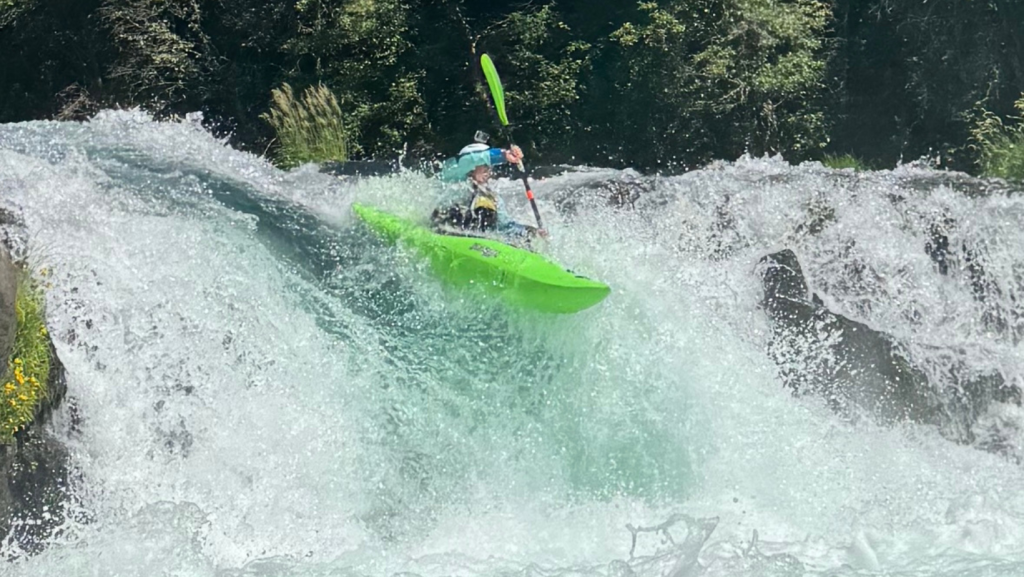
BANG, CLUNK, SMACK. I hear over the torrential downpour, as I pull away from the stop sign on the side streets of Fort Collins. I get out of the car, and my kayak—a white and purple Dagger Mamba—is on the ground, covered in mud.
On my drive home from the Poudre, I was buzzing. Pumped and exhausted from the adrenaline, problem-solving, and paddling, I see we did not strap the boat correctly. Obviously. A miscommunication between two new kayakers is the likely culprit. The boat seems to be fine. No dents. The car looks ok. No one is behind me. Now getting pummeled with rain, I pick up the dirty boat and put it back on my car, figuring out how to strap this thing in the pitch black. This is how my first day of kayaking ended.
It started with me rear-ending someone on the way to the take-out while looking at my map. After this, and safely off the road in the river, I flipped, couldn’t roll, and proceeded to swim. TWICE. Then, I lost my drain plug. Go figure. This sport was bringing full chaos to my life. Luckily, nothing and no one was hurt (except for my ego). You could say it was a complete disaster. But for some reason, I kept coming back.
Over the past four seasons, I’ve made a point to spend as much time in my boat as possible, being intentional with my paddling—practicing specific skills every day I’m on the river after work, catching every eddy, testing new lines, exploring different rivers, or trying out new boats. One of my favorite drills—taught by a good friend—still pushes me out of my comfort zone: paddling into all the “friendly” holes to practice surfing and escaping. It’s a great way to get used to being stuck or window-shaded in low-consequence settings, rather than during a high-stakes run. Managing risk is key—it lets you keep coming back, even when it’s scary.
Much of my life, I thought more structure would make me more successful, happier, and fix my problems. Endless color-coordinated spreadsheets and to-do lists with no free time to even have coffee with a friend ruled my life. This philosophy was challenged by the river, where things are constantly changing.
You have to work with the water, a big, powerful force you have no hope of controlling. How do you react? In absolute anxiety and fear, or in an easy-going calmness? The river is on its own timeline, and I am just happy to be there. Kayaking makes you confront your fears while also being very forgiving. And water is a forgiving medium until it’s not. Whitewater can bring concepts like risk assessment, trust, community, joy, fear, and death to the forefront.
Progressing in my kayaking career, I found a great community of genuine, weird, amazing people all united by their love of paddling. I value having trustworthy friends and teachers that give advice, lead lines, and save my ass if and when I need it. I want to do that for others.
My parents were high school teachers, and I saw how just one mentor can make a big impact on someone’s life. Just this year, I was certified as an ACA L4 Whitewater Kayaking Instructor, teaching for Rocky Mountain Adventures. I’m excited to share this amazing sport because there isn’t a lot of formal instruction out there. In the chaos and messiness of running rapids, swimming, and shuttle logistics, I hope others can also find an overwhelming sense of joy and peace.
Thank you to Taylor Stoudnour for contributing “Calm Within the Chaos” to the ACA Story Project! Taylor’s story reminds us that growth happens not in the absence of chaos, but by leaning into it.
About the Author
Taylor Stoudnour joined the ACA earlier this year after completing an ACA Level 4: Whitewater Kayaking Instructor Certification Workshop with Rocky Mountain Adventures in Fort Collins, Colorado. Though she’s quick to downplay her accomplishments, Taylor’s rapid progression in the sport speaks volumes. Her commitment to improving her skills — from evening slalom clinics in Lyons to winter kayak polo sessions — is as inspirational as it is effective. With a passion for teaching and a deep respect for the river, Taylor is helping shape the next generation of paddlers with skill, humility, and heart.

